Technology at Chinaplas
Also, download this story from the electronic issue here
Materials
- Chemicals firm BASF will exclusively co-host the Design x Innovation event, showcasing how innovative materials enable new product designs in the areas of mobility, sports and leisure, as well as building and living. In addition to product exhibits, the event will feature industry expert discussions at open forums. The focus of the event lies on plastics technologies that enable product designs, which address evolving customer needs, sustainability demands and regulatory requirements.
- Thermoplastic elastomer (TPE) specialist Kraiburg will focus on its Thermolast K UV/HF series, for automotive exterior applications requiring high UV resistance and high flowability. TPEs based on styrene block copolymers (TPS) have the advantage of production flexibility that are applicable to a diverse range of products and can be customised via the choice of additives, dyes and other thermoplastics. They are also less demanding in terms of processing parameters than other TPE materials, such as TPVs and TPUs. As a result, they do not experience significant loss of UV resistance at critical processing parameters, such as high shear rates or elevated temperatures. Besides easy flowability, the series has perfect adhesion to PP. It is tested according to PV3930 for outdoor use on applications such as cowls, gaskets, roof rims, water deflectors and window encapsulations.
- Meanwhile, as the demand for wearable devices like ear pieces, eyeglass frames and watches increase, so has the demand for comfortable, silky soft, and irritation-free material. Kraiburg offers Copec, a TPE totally free of all latex, PVC and heavy metals. It is processed as part of dual-component injection moulding with polycarbonate (PC) using an approach that simplifies manufacturing, slashes cycle times and eliminates the need for additional work procedures. The material is colourable with colour stability to meet the diverse needs of the fast expanding wearable personal devices market.
- Soft-touch overmoulding technologies have radically changed the design possibilities for consumer and industrial products, by including tactile and non-slip features and expanded colour, texture and functional options. Thus, compounding group Hexpol will present new Dryflex TPE compounds for PA overmoulding. Due to its high strength, impact and high temperature resistance, PA is often used in power tools, with TPE adding safety features such as a non-slip grip or ergonomic handle. It offers grades with high bonding strength to PA6, PA66, PA12 and PA blends as well as reinforced PA with up to 40% glass fibre, with wide processing window from 200°C- 280°C. The compounds can be processed via insert and multi-shot processing technologies.
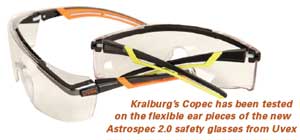
Pipe Extrusion
- Pipe machinery maker Unicor has introduced the UC36 G2 corrugator for manufacturing technical pipes with diameters up to 135 mm. It can achieve production speeds of up to 60 m/minute, and with 80 pairs of mould blocks can reach outputs for PVC corrugated pipes (cable conduit) of up to 250 kg/ hour.
- Unicor completely redesigned the mould blocks, with uniform cooling for four external sides of the mould blocks for even heat distribution. Adjustments have also become a thing of the past thanks to a mechanical allocation solution.
- To guarantee a long lifespan with minimal maintenance, Unicor says it uses parts from German suppliers, such as the servomotor, gears and touch display. The basic version of the corrugator is equipped with 50 pairs of mould blocks. This can be expanded to 65 or 80 pairs to increase production capacity. The optional vacuum can also enhance the production of corrugated pipes for a wide variety of applications.
- Battenfeld-cincinnati (Foshan) Extrusion Systems will feature the largest of three extruders, the LeanEX 90, at the show. The single-screw extruders are built at its facility in China using European technology, selected European components and locally sourced screws, barrels, motors. It offers three available extruder sizes: 60, 75 and 90 mm with outputs ranging from 350-800 kg/hour for HDPE and from 280-600 kg/hour for PP-R. It will also show the twinEx 93-28D twin-screw extruder, for profile/pipe as well as PVC sheet extrusion, with outputs ranging from 115 kg/hour-2,500 kg/hour.
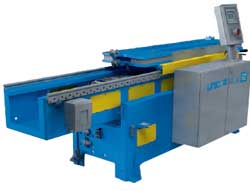
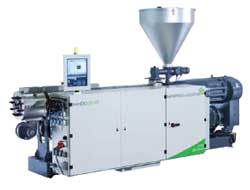
Film Extrusion
- Windmöller & Hölscher (W&H) will present the modular Aquarex blown film line with water cooling as well as the newly developed Aquacage, which allows automatic adjustment of the bubble diameter and thus increases the form flexibility of the line. The demand for new, innovative films is increasing in all areas of application and industries. Asian customers as well appreciate the high quality and the innovative properties of films produced with water cooling, says W&H.
- The Aquarex blows film downward and uses water instead of air to cool the bubble, allowing for rapid cooling of the melt, thus keeping crystallinity of the film low and maintaining its amorphous molecular structure. The resulting positive film properties are high clarity and gloss as well as good sealability, puncture resistance and favourable thermoforming properties. The newly introduced Aquacage can automatically adjust the bubble diameter for film widths between 750 and 1,250 mm, similar to conventional blown film lines.
- Brückner Maschinenbau will focus on battery separator film lines with a working width up to 4.5 m. It will also show a new solution called “decentralised electric”. All power switches, motor control units, frequency converters, inputs for sensors and outputs for actuators are directly linked to the machine components. With this plug-and-play solution the commissioning time can be optimised, allowing for cost reduction and the availability of an energy monitoring for each machine unit.
- Lindauer Dornier will focus on polyester condenser film plants, available for thickness down to 1 micron and a trimmed width of 5.5 m. For thick film application, Dornier provides production lines up to a maximum film thickness of 400 microns and a width up to 7 m. For production of packaging films lines with a thickness range of 8-125 microns, a trimmed width of 10.6 mm and speeds up to 600 m/minute are the norm. For PP applications, its production lines are designed for a thickness of 10-50 microns, a trimmed width of 10.5 mm and speeds of 600 m/minute. The company also supplies lines for BOPET film production, for optical film for LCD displays.
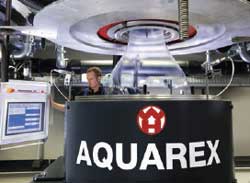
Auxiliary Equipment
- Nordson Corporation will supply 16 units of its process-patented BKG CrystallCut pelletising systems for a mega-scale PET resin plant scheduled for start-up this year by Jiangyin Chengold Packaging Materials, a part of the Chengxing Group, in Jiangsu Province, China. The big project reflects the intensified focus on pelletising systems for the Asian marketplace. The system uses the thermal energy of the molten polymer in PET pelletising for subsequent crystallisation, allowing for energy savings. In the Chengold facility, the CrystallCut systems will deliver PET pellets to EcoSphere solid state polycondensation (SSP) systems built by Polymetrix of Switzerland, which contracted the use of the CrystallCut units. Chemtex Group from the US is the prime contractor for the entire bottlegrade PET resin plant.
- CrystallCut system integrates underwater pelletising, drying, water filtration and direct crystallising at temperatures of up to 180°C and crystallinity up to 40%. Nordson BKG will also supply 16 condensation systems for the water recovered from the hot air in the process, for additional savings through reduction in water filling.
- ProTec Polymer Processing's focus will be on the production of long-fibre-reinforced thermoplastics (LFT) by pultrusion and on the new generation ProTec tumble reactors. These SSP (solid-state post-condensation) reactors are ideally suited to improving the properties of flowable plastics. ProTec's headquarters in Bensheim (Germany) has a pultrusion line for application-specific customer testing. It features a compounding extruder equipped with a Somos Gramix S gravimetric dosing system capable of dosing and mixing up to nine components. Thus, it allows for a wide range of individual formulations, including recycled material and additional fillers.
- Following the takeover of the two companies, Gala Industries and Reduction Engineering Scheer, last year, Switzerland-headquartered Maag will be exhibiting the company’s expanded product portfolio for the first time. It will introduce the new Pelletizer MAP6, with knives adjusted by means of a handwheel so that the operator can monitor the knife wear visually. The new valve that diverts the polymer stream between starting and production position switches in less than one second.
- Centrifugal dryers, like the Centro 150, are used to dry pellets after underwater pelletisation. It is designed for an output of up to 22,000 kg/hour and consumes up to 40% less energy. It will be on show together with the PWS25 process water treatment System. The Centro was designed in Germany, and thanks to local production in China can be offered at a good price/ performance ratio.
- It will also show a new design of the Baoli strand pelletiser, the 200 S, and the new Generation 6 Extrex extrusion pumps, which can be operated at lower speeds while achieving the same throughput.
- Maguire Products says it is on course to shipping its 50,000th gravimetric blender. On exhibit will be a copper-plated version of the company’s MicroBlender, the smallest model in the blender range. In following months, this blender will be on display at local events around the world as the company marks the milestone sale. A gravimetric batch blender sequentially dispenses each batch ingredient in its target proportion into a weigh chamber; by monitoring each gain in weight of a batch, the blender control makes adjustments to subsequent batches to maintain accuracy and control raw material consumption. The system is said to hold batch accuracy to within +/- 0.1%.
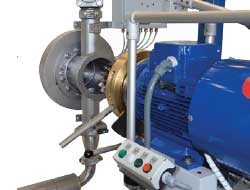
Thermoforming
- Switzerland-based WM Wrapping Machinery has in its range the FT series forming-trimming machine with lower tilting platen; FC series form+cut+stack machines with steel rule cutting and Intec series with complete in-line solutions, including extruders and all peripheral units for a real production island, including the recycling of scraps. It is now developing a new thermoforming machine and stacking system for 10,000,000 machine cycles, to be shown at the K show in October.
- Meanwhile, after launching its first generation of the Twist 300, WM recently delivered another second generation unit to Europe. The Twist 300 in-mould trimming with lower 90 degrees tilting platen has a forming area of 340 x 230 mm with a clamping force of daN 10,000 for thermoforming products with a maximum negative depth of 120 mm. It is beneficial to mould makers who are seeking mono-cavity moulds for cheaper new product sampling; for production of small quantities for preproduction testing or feasibility studies and for small productions to cover niche markets.
- Kiefel presents the punch press KES 85, with peripheral punching technology for the first time in Asia. The system enables notch-free processing of formed parts. For punching and stacking of trays, lids and formed products with special requirements, it recommends the KMD 78F Speedformer, combined with the eccentric punch press KES 85, for 120 cycles/minute. The vertical punching system minimises the effect of transverse forces. All cycle movements are servomotor-driven. Combined hole punching and periphery punching is possible. The whole tool block can be changed easily and quickly with a crane, while operation is achieved by the Siemens Simotion control system. The KES 85 is suited for the production of parts of PS, PP, PE, PVC, PET and PLA.
- Battenfeld-cincinnati China will introduce the Multi-Touch roll stack, which is an optimal solution for producers who are not prepared to compromise on sheet quality, even at high line speeds. It allows a high degree of transparency and flatness and even sheet thickness can now be achieved for PS, PET or PP, as well as EVA or laminated products. High-speed single-screw extruders complement the Multi-Touch roll stack, adding a solution for high-end applications in terms of both quantity and quality.
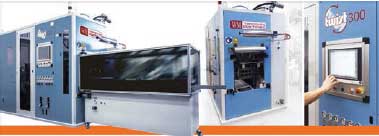
Recycling Equipment
- Recycling equipment specialist Erema will be exhibiting the Intarema 1007 TVEplus with an Erema SW4/104 RTF melt filter. This system will be shown live in action with a throughput of 300-350 kg/hour to present the efficient recycling of heavily printed LDPE materials. The high demand for TVEplus technology is explained by the special challenges faced in recycling processes for heavily printed materials. Binding agents and other additives that are constantly found in the inks, for example, are a problem as they melt at the processing temperatures of the plastic matrix and break down in parts. TVEplus technology, developed by Erema, offers efficient filtration, homogenisation and degassing at the highest level. This means that high-quality recyclates which are, for example, reused in the production of film, can be made even from full-surface and multiple-layer printed film scraps in a single pass.
- Erema says it has over 4,500 recycling systems in use around the world, and has expanded its offices to China, US and also, more recently, to Russia. Its subsidiary in the US is also expected to more than double the size of its trial centre, in response to the high demand.
- It achieved a milestone last year with the founding of the new Erema sister company Pure Loop, which specialises in the recycling of clean production wastes.
- Pallmann presents the latest PFV Plast-Agglomerator, able to handle waste coming from production of film, fibres, foam, carpets or other mixed materials, from PP, PE, PVC, ABS, and XPS as well as compounded materials. The waste precut into 8-10 mm pieces is plastified by means of frictional heat, pressed through a die and cut at the outer circumference by rotating knives. The agglomerated material is transported pneumatically to a downstream hot melt granulator, creating free-flowing granules with a high bulk density and a minimum of thermal degradation. The modular system can be premounted on a base frame, including wiring and water hook-up, simplifying installation.
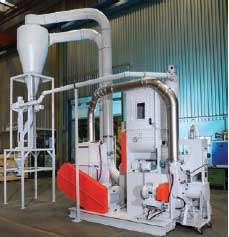
Injection Moulding Machinery
- Machinery maker Arburg will feature its newly launched all-electric Golden Electric series, which it says is set to emulate the success story of the entry-level hydraulic Golden Edition series. The new models make use of standardisation to offer an excellent price/performance ratio, for example, through a fixed combination of distance between tie-bars, clamping force and injection unit size. Available are four 370, 470, 520 and 570 sizes with clamping forces of 600, 1,000, 1,500 and 2,000 kN.
- The double five-point toggle ensures fast, highperformance cycles. The play-free spindle drives operate with great precision. The position-regulated screw enables cavities to be filled with a high degree of repeat accuracy, ensuring high injection quality.
- They also feature liquid-cooled motors and servo inverters and also offer benefits in terms of energy efficiency, short dry cycle times and high reproducibility. Compared to hydraulic standard machines, the high efficiency of the servo motors, continuous power adaptation and energy recovery during braking mean that up to 55% less energy is required. The machines are also easy to maintain thanks to swivelling injection units, plug-in cylinder modules and further improved lubrication and cooling.
- The Golden Electric series is designed for standard use like technical injection moulding. Owing to the benefits offered, an increasing number of processing companies are interested in electric machines that combine features such as precision, energy economy and reproducibility at a low cost for standard applications, says Arburg.
- Chinese company Haitian Group, one of the world's largest manufacturers of injection moulding machines, says last year it delivered around 26,000 machines and recorded a turnover of RMB7.34 billion, which is a slight decrease of 3% compared to the previous year. Despite the ongoing difficult operating environment, the group’s sales in China recorded a mild drop of 4%. In the export markets, Haitian says in some regions such as Vietnam, South Korea, India, Europe and Mexico, it recorded impressive sales growth, “with a mild drop of 1.6% compared to 2014”, and the second highest exports ever.
- To cope with the challenges in the market during the year, Haitian continued converting small tonnage hydraulic machines to electric solutions and large tonnage machines to twoplaten solutions. The sales of the all-electric Zhafir Venus series increased by 30% to more than 1,600 orders, a jump of 46% compared to 2014. Sales of the large two-platen Jupiter series reached nearly 500 units, up by 40%, over 2014. The Mars series remained the bestseller and accounted for nearly 70% of total sales. It says in 2016, new production plants in Germany and India will be put into operation. Moreover, the existing sites in Brazil, Vietnam and Turkey have been expanded with application centres, as well as in Indonesia, Mexico and Thailand.
- Dr Boy will introduce its XS (100 kN clamping force), making miniature gear wheels, and servodriven 25E with servo drive (250 kN clamping force) at its distributor Andeli’s booth. Its E series scores as precise and efficiently working injection moulding machines, with the servo-motor pump drive and the optionally available EconPlast plasticising technology, says Boy.
- Austrian machinery maker Engel celebrates its 30th year in Asia, with the founding of its subsidiary in Hong Kong in 1986. It started in Asia with four staff members, and today there are more than 500 in China alone, and South Korea has more than 180. In 2014, Engel set another milestone in its Asia strategy with the foundation of its Wintec subsidiary in Changzhou, China, to manufacture machines in Asia for standard applications. A new production plant of its own has been established in Changzhou and the company aims to run independent of Engel.
- The Asian market contributes substantially to the 40-year old Wittmann Group, which has a plant in Kunshan, China, where robots, temperature controllers, material loaders and granulators are manufactured, primarily for the Asian market.
- Its subsidiary Wittmann Battenfeld will demonstrate two models. On a MicroPower 15/10, for the moulding of small and micro parts, it will show an opto-electronic application. A barrel holder made of POM will be produced with a mould supplied by Wittner, Austria. This component is a focusing device used mainly in cameras to hold the lenses in place or to focus them. The second model on display will be the SmartPower servo-hydraulic machine. It will also show the integration of robots and peripheral equipment with the control systems of machines, known as Wittmann 4.0.
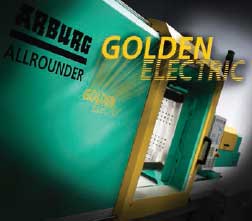
Home | Terms & Conditions | Privacy Policy | Contact | Webmail | Site Map
Copyright (c) 2016 www.plasticsandrubberasia.com. All rights reserved.








































